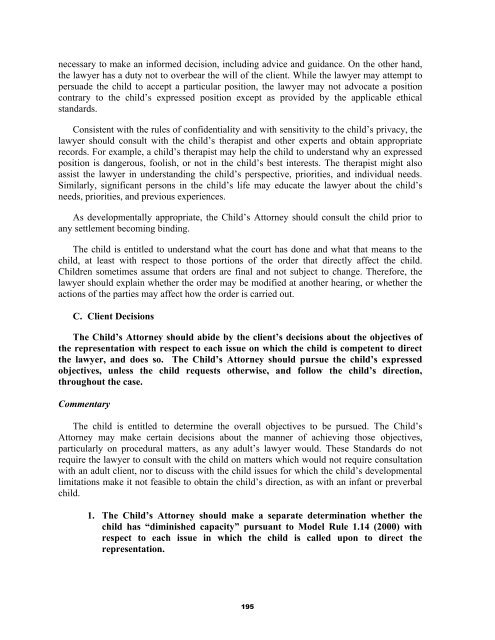A Judge’s Guide
A Judge’s Guide
A Judge’s Guide
You also want an ePaper? Increase the reach of your titles
YUMPU automatically turns print PDFs into web optimized ePapers that Google loves.
necessary to make an informed decision, including advice and guidance. On the other hand,<br />
the lawyer has a duty not to overbear the will of the client. While the lawyer may attempt to<br />
persuade the child to accept a particular position, the lawyer may not advocate a position<br />
contrary to the child’s expressed position except as provided by the applicable ethical<br />
standards.<br />
Consistent with the rules of confidentiality and with sensitivity to the child’s privacy, the<br />
lawyer should consult with the child’s therapist and other experts and obtain appropriate<br />
records. For example, a child’s therapist may help the child to understand why an expressed<br />
position is dangerous, foolish, or not in the child’s best interests. The therapist might also<br />
assist the lawyer in understanding the child’s perspective, priorities, and individual needs.<br />
Similarly, significant persons in the child’s life may educate the lawyer about the child’s<br />
needs, priorities, and previous experiences.<br />
As developmentally appropriate, the Child’s Attorney should consult the child prior to<br />
any settlement becoming binding.<br />
The child is entitled to understand what the court has done and what that means to the<br />
child, at least with respect to those portions of the order that directly affect the child.<br />
Children sometimes assume that orders are final and not subject to change. Therefore, the<br />
lawyer should explain whether the order may be modified at another hearing, or whether the<br />
actions of the parties may affect how the order is carried out.<br />
C. Client Decisions<br />
The Child’s Attorney should abide by the client’s decisions about the objectives of<br />
the representation with respect to each issue on which the child is competent to direct<br />
the lawyer, and does so. The Child’s Attorney should pursue the child’s expressed<br />
objectives, unless the child requests otherwise, and follow the child’s direction,<br />
throughout the case.<br />
Commentary<br />
The child is entitled to determine the overall objectives to be pursued. The Child’s<br />
Attorney may make certain decisions about the manner of achieving those objectives,<br />
particularly on procedural matters, as any adult’s lawyer would. These Standards do not<br />
require the lawyer to consult with the child on matters which would not require consultation<br />
with an adult client, nor to discuss with the child issues for which the child’s developmental<br />
limitations make it not feasible to obtain the child’s direction, as with an infant or preverbal<br />
child.<br />
1. The Child’s Attorney should make a separate determination whether the<br />
child has “diminished capacity” pursuant to Model Rule 1.14 (2000) with<br />
respect to each issue in which the child is called upon to direct the<br />
representation.<br />
195


